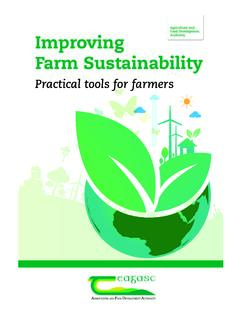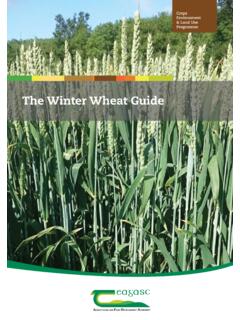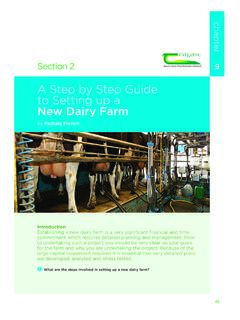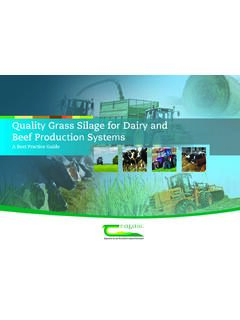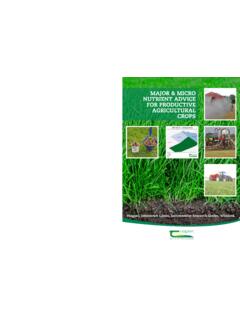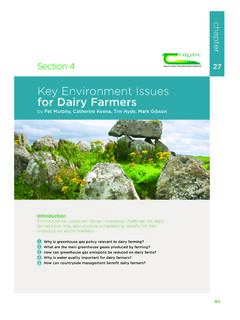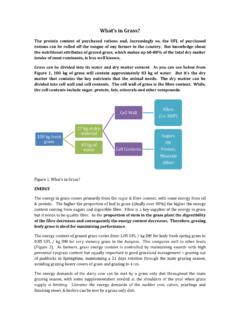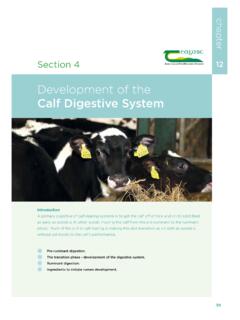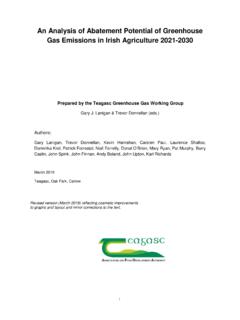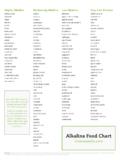Transcription of Feeding the Dairy Cow (Concentrates) - Teagasc
1 21323chapter35chapter Feeding the Dairy Cow (Concentrates)by Siobhan KavanaghIntroductionWith concentrated prices expected to remain high, they must be used prudently. What should I look out for in concentrate mixes? How do I investigate nutrition related problems?12 Section 621435chapter Feeding the Dairy CowWhat should I look out for in concentrate mixes? How toChoose the concentrate mix that is right for you11. Energy is the most limiting nutrient in Dairy diets - always check the energy content of the concentrate . The energy density of concentrate mixes for high levels of performance should be UFL/kg or greater as fed. 2. Check the protein content of the concentrate . This will vary with type of animal, stage of lactation and the base forage being offered. Always balance the protein content of the concentrate with the protein content of the Unless Feeding minerals separately, check that minerals are included in the concentrate mix.
2 Check that the Feeding rate of the concentrate mix supplies the correct daily amount of minerals, calmag inclusion to match Feeding rate during the high tetany risk In buying concentrates the nutrient content ( energy, protein, minerals, fibre) is more important than the individual ingredient composition. Always buy concentrates on the basis of nutrient content. 5. If using straight ingredients, it is important to check that these are correctly balanced for all nutrients, particularly minerals. ConcentrateFeed SpecificationEnergy(UFL) + UFLFor lactatingcows, Feeding rate:2kg+ + UFLFor mineralcarrier, Feeding rate:< CP- silage +concentratesGrazed grass+ concentratesin the diet24-28% CPGrass silage + maize silage +concentrateProtein(Crude Protein)12-16% CPGrassConcentratefeed specificationEnergy(UFL) + UFLFor lactatingcows, Feeding rate:2kg+ + UFLFor mineralcarrier, Feeding rate:< CPIndoor diets- silage +concentrates16-18% CPGrazed grass+ concentratesin the diet24-28% CPGrass silage + maize silage +concentrateProtein(Crude protein)21523chapter35chapter ChecklistGetting value for money1.
3 Always ask for information on the nutrient content of the concentrate energy, protein, minerals and Shop around there can be a lot of variation in price but always ensure that price differentials are not explained by variations in nutrient content compare like with The cheapest concentrate mix may not be the best value. Consider the value of the feed based on its Feeding value relative to its High protein concentrate mixes don t necessarily have high energy content. The energy content of a 14% CP concentrate mix could be higher than an 18% CP concentrate mix. 5. Don t assume that straight ingredients are better value than concentrate mixes. Always check the price of buying straights (and home mixing), relative to buying a standard concentrate mix. 6. Only buy from appropriately licensed suppliers. Key factCalculating the relative cost of different feeds can be difficult. Teagasc has an interactive calculator on its website where the price of barley and soya can be entered and the relative value of different feeds is calculated of thumbRolled barley has a UFL of All other feeds are expressed relative to barley.
4 For example, soya hulls has a UFL of , which is 88% of the value of barley, on an energy basis. 21635chapter Feeding the Dairy CowCommon ingredients Energy feeds Comments Barley High starch, risk of acidosis at high Feeding rates, do not feed at high rates in grazing concentrate mixes Wheat High starch and rapidly digestible, higher risk of acidosis than with barley or maize , high substitution rate at grass maize grain High starch but slowly digestible, risk of acidosis less than barley or wheat Citrus pulp Good source of digestible fibre and sugar, suitable supplement at grass Beet pulp Good source of digestible fibre, high energy, suitable supplement at grass Soya hulls Good source of digestible fibre, moderate energy content, suitable supplement at grass Wheat feed By-product from flour processing, low energy (pollard) feed 21723chapter35chapter Soyabean meal The best quality protein feed, high in by-pass protein, not necessary in a grazing situation unless cost competitive Molasses Useful for binding pelleted concentrates, reducing dust and improves palatability of concentrate mixes.
5 Typical inclusion of 3-6% in the concentrate mix Protein Feeds maize distillers High energy, moderate protein, high oil which grains can affect milk fat if percentage of total unprotected fat in the diet exceeds 6% maize gluten feed Moderate energy, moderate protein, variable quality Rapeseed meal High protein, a good source of rumen degradable protein, palatability issues at high inclusion rate Palm kernel meal Low energy feed; limit its use in high energy mixes Sunflower meal Low energy feed, high protein content but protein is of poor quality21835chapter Feeding the Dairy CowRule of thumb1 kg DM of grass is the equivalent of 1 UFL/kg DM. concentrate mixes will have a UFL varying from UFL/kg as fed (or DM). Target energy density for high quality concentrate mixes is UFL/kg as fed, depending on the quality of the ingredients used. How do I investigate nutrition related problems?
6 1. Excessive body condition loss1. Low dry matter intake (see checklist for factors causing low dry matter intake).2. Inadequate Poor quality Metabolic Inadequate trough space Excessive dietary Cows overfat at Low milk protein Cows may not be genetically capable (see EBI score) of producing high milk protein. Low energy intake limits protein digestion in the rumen and limits milk protein production. Low energy intake can be due to: - inadequate dry matter intake due to a limited supply of grass, low grass digestibility, overestimation of grass supply and poor grazing conditions. - grazing high pre-grazing covers of grass (>1,600 kg DM/ha), resulting in low digestibility, low energy grass - poor quality forages low digestibility silage. Stage of lactation milk protein % dips 4-6 weeks after calving due to dilution ( peak milk yield dilutes the % of fat + protein).
7 This is most notable where compact calving was achieved. Always calculate the total production of milk solids, milk protein % may have dropped but total kg of milk solids production may be high. Mean calving date late calved cows tend to have lower milk protein in mid-season. High levels of oil in the complete diet will depress intake and consequently milk protein. This is only likely to be a problem in indoor diets. Ingredient type high energy feeds such as grass will stimulate milk protein production. In indoor Feeding systems, maintaining starch levels at 20-25% of total intake will help maintain milk protein Low milk fatInsufficient fibre in the diet is the most common cause of low milk fat. What might cause low milk fat: cows grazing low covers of lush grass with little fibre. (Providing cows with a source of fibre such as straw or hay may help. Don t overreact to a short-term drop in milk fat content.)
8 High levels of concentrate feed with grass of low fibre content high levels of cereal/rapidly degradable carbohydrates in the concentrate feed (Grazing concentrate mixes should be based on a high fibre ingredients such as pulps and hulls.) 221923chapter35chapter4. Low milk lactoseAs milk yield declines, so too does milk lactose. Low milk lactose is generally a problem in late lactation. Dry the herd off when production averages less less than 8-9 litres. Dry off any cow producing less than litres/day. Where grass quality and/or grazing conditions are poor, Feeding 2-3kg of concentrates helps maintain milk yield and consequently lactose levels. High somatic cell count results in low lactose content, irrespective of stage of lactation. 5. Milk fever (clinical/sub-clinical) Always consultyour veterinarian about treatment of these diseases)Clinical milk fever is easily diagnosed with the classical downer collapsed cow, but sub-clinical milk fever is more difficult to diagnose.
9 Signs of sub-clinical milk fever include slow, difficult calvings, retained cleanings, low dry matter intake and uterine infections. To reduce the risk of milk fever (clinical & sub-clinical): Avoid having cows at a condition score greater than (or less than ) as they are at higher risk of both types of milk fever. Late calving cows are at greater risk of being over-conditioned due to the long dry period. Watch the age profile of the herd. Milk fever is more prevalent in 3rd calvers and older cows. Ensure animals have adequate Feeding space (2 per cow). Offer cows fixed rate minerals. Fixed rate Feeding of minerals is most accurate. Supplement with 15-25g/day of magnesium. Check the pre-calver mineral to ensure the Feeding rate is correct. Avoid high potassium levels in the base forage. High potassium levels in grass silage, due to excessive spreading of slurry on silage ground in late spring can limit the uptake of magnesium from the gut, increasing the risk of milk fever.
10 Treatment: Inject, as soon as possible, with a bottle of calcium under the skin. If it s a particularly bad case of milk fever, injection into a vein may be necessary but this should be left to a veterinarian as it can cause sudden death if not carried out properly. Retained cleaningsRetained placenta is when the foetal membranes fail to separate from the womb of the cow within 24 hours of calving. Cows with retained cleanings are at higher risk of developing metritis, ketosis and mastitis and are at increased risk at subsequent calvings. This can be prevented by: having cows fit (BCS = ), but not fat calving down. ensuring the diet is correctly balanced for minerals, particularly magnesium and trace elements. (Iodine and selenium have an important role to play in reducing the risk of retained cleanings. Supplement with 60mg and 5mg of iodine and selenium, respectively.) reducing the risk of clinical and sub-clinical milk fever.
